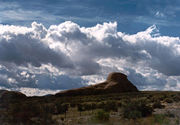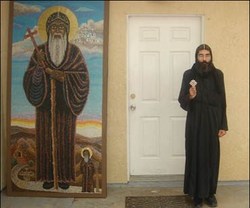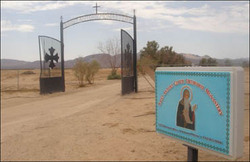Featured Article
California Dreaming
Flak Magazine
http://www.flakmag.com/features/copts.html

California Dreaming: The Copts' Desert Monastery
By Mark Goldrup
NEAR BARSTOW, CALIFORNIA — As deserts go, the Mojave does not have much to boast about. It's not the biggest (that's the Sahara), nor the hottest (ditto), nor the driest (Atacama). But it does seem to have the market cornered on weird.
Along with a few Joshua trees and a fair bit of sand, the Mojave is home to the space-alien-and-geek-infested Area 51, the reconstituted London Bridge, the pastel suburbs of Los Angeles' northern fringe, the unadulterated adulterousness of Las Vegas, and the odd mobile-home meth lab or two. It is, as was once famously observed, "a place where they've taken a desert and turned it into their dreams."
If that's true, the prevailing indications are that "they" dream mainly of 40-foot-tall neon stripper billboards and labyrinthine outlet malls. But that is not universally the case. In a sweltering valley outside Barstow, just about perfectly half-way between Las Vegas and Los Angeles, is a place where a handful of men dream about things decidedly less worldly.
"The desert," says Father Marcus St. Antony of the dusty but vibrant Coptic Orthodox Christian Monastery of St. Antony, "has a spiritual effect on the mind and senses."
Mark Goldrup
Father Marcus St. Antony stands next to an icon of St. Antony. The monastery's namesake saint is regarded (along with St. Paul the Hermit) as one of the founders of the Christian monastic movement.
He is not alone in this view. It is one held in common with many of Father Marcus' Egyptian compatriots (The term "Copt" is derived from the ancient Greek name for Egypt and, barring a few converts, modern Coptic Christians are either Egyptian or descended from Egyptians). The first Christian monasteries were founded in the Second and Third Centuries by hermits who simply walked off into the rugged deserts beyond the edge of the verdant Nile River Valley. They left the cradle of civilization's infancy, the classical world's most well-stocked markets, and the home to massive monuments already considered ancient by the beginning of the Christian era.
From the earliest days of these proto-monks, it was understood that the desert, with its near-total absence of worldly comforts and the ever-present possibility of an early exit into the world to come, was an ideal environment for a man to attempt ridding himself of sin.
The move turned out to be a smart one. As Egypt's cities were racked by riots and factional fighting during the doctrinal free-for-all of Christianity's first few centuries, the isolated monasteries grew quietly, peacefully, steadily.
The Coptic Church was among the first to part ways with the rest of Christianity when the Egyptian bishops refused to attend the Council of Chalcedon in 451, claiming that Imperial Rome was manipulating the ecumenical councils for political ends. Today, Copts are closely aligned with the other "non-Chalcedonian" Orthodox churches (Ethiopian, Armenian, Assyrian, and a few others), and accept the baptisms of members of these churches. In recent decades, there have been some attempts to warm historically cool relations with other Eastern Orthodox churches (such as the Greek) and with Western Catholics and Protestants.
After the Arab conquests of the 7th Century, a general peace prevailed and Christianity enjoyed status as a religion protected by Islamic law — most of the time. Since then, the numbers of Christian Egyptians have declined slowly into minority status (they are now about 10 percent of a population of 70 million) and the pressure to avoid offending the dominant group has increased, especially in recent years as the Islamic world has faced its own pressures and less tolerant forms of Islam have gained sway in some quarters. The monasteries within Egypt and without have come to represent a place where this pressure does not exist, where Copts' religion can be practiced without fear of offending the neighbors.
"Monasticism has a very important role for us. It is the spirit of the Church," says Father Marcus. "Through ages of persecution that left many churches burned and demolished, it was monasticism that preserved our books and ideas."
Mark Goldrup
The curved steel beams of a half-built church on the monastery compound.
In recent decades, the key threat to the Coptic Church has come from Salafist Islamic extremism, ascendant in today's Egypt. The Coptic heartland around the cities of Assyut and Minya in Upper Egypt also happens to be the birthplace of some of the most strident Salafist groups in the Arab world. Religious rioting in these parts is not unheard of, and Copts tend to wind up on the losing side most of the time. With the hometown faithful in such a precarious position, Father Marcus says the Church needs to walk a careful line.
"Within Egypt, there are limits on everything — on building churches, on ringing church bells, on representation in the Maglis Esh-Shaab [Egypt's legislature]," he says. "Sometimes people can express their faith, and sometimes not. Here in the United States, of course, we have much more freedom to worship as we want to. The challenge here is more about people keeping faith in religion as a whole, not only in the Coptic Church."
The monastery in the Mojave represents one potential solution to the existential quandary of a church whose identity is intimately tied to a country in which its adherents are a weakened minority. In this sun-baked valley, as many as 1,000 Copts gather on religious feast days to receive communion and spiritual guidance from the eight monks and priests who live here permanently. Beyond serving the American Coptic community, the Church may also hope that this and other religious outposts allow it to develop a stronger, more independent position to lobby on behalf of Copts within Egypt.
Tucked away at the end of a long, rutted dirt road, at first glance the monastery is perhaps more impressive in its heavenly ambitions than in its architectural accomplishments. The grounds are dotted with unmanaged desert shrubs, the buildings drab and plain.
The eight monks who live there full-time, devoting themselves to prayer and study in their private hours, are often surrounded by Egyptian Christian visitors in the daytime. Along with the chance to receive guidance from the church fathers, it is not hard to see what might attract the homesick worshippers. The place is Egypt. The caretakers and groundskeepers tease each other in the easy slang of Egyptian colloquial Arabic, going about their work with the same good humor and lack of haste as their counterparts back home. Cups of hot, sweet tea are served, even in mid-summer. There is a fine layer of desert dust coating everything — the low-slung buildings and trailers, the small chapel still under construction, the icons and plaques in the humble courtyard — that calls to mind the dilapidated Christian quarter of Old Cairo.
The place feels like Egypt in more than just a physical sense; also present is the delicate struggle to preserve tradition without antagonizing enemies. "There have been some attempts to strengthen the Church in Egypt [through lobbying in America], but we must be careful not to enrage fanatics inside Egypt," Father Marcus says. "The Pope [Baba Shenouda III], even when he visits us here in America, is careful about these issues and he doesn't say anything to make the fanatics mad," he says, then pauses for a moment before adding, "even if it's the truth."
But truth and fantasy are negotiable in the Mojave, and whatever the difficulties back home, the monastery continues to grow unimpeded in the empty space the monks have found here.
Most American settlers to the area — early and late — dreamt mainly of accumulated wealth and the pleasures thereof. The towering, pyramidal monuments to kitsch along Las Vegas Boulevard stand in unsilent testimony to this fact. And out here in the rugged desert beyond the edge of the Interstate, as one considers the troubles within Egypt and surveys the small, half-built church and scattered double-wides that comprise the monastery, it is difficult to avoid wondering whether the monks' dreams are simply another humble contribution to the Mojave's abundant store of absurdity.
Maybe. But if so, it is a unique contribution, one that re-imagines the meaning of the desert, and the peculiar opportunities for freedom that reside here for those willing to dream.
All materials copyright © 1999-2007 by Flak Magazine
http://www.freecopts.net/forum/showthread.php?t=16822
E-mail Mark Goldrup at markgoldrup at gmail dot com.
Father Marcus at abouna@saintantony.faithweb.com
Mark Goldrup, The entrance to the Coptic Orthodox Christian Monastery of St. Antony in California's Mojave desert.
The entrance of Saint Antony church. This mosaic icon is especailly made for the new large church of Saint Moses the black in the monastery
_______________________________
A religious tradition born in Egypt finds a home in California desert
NEWBERRY SPRINGS, Calif. -- Down an unpaved road, past brooding icons and swaying stands of mesquite, lies St. Antony's Monastery, a place of scorching winds and emptiness that perhaps only a holy man could love.
Little moves when the sun is high, but as the day wears on, black figures emerge from solitary rooms. These shrouded men, most from Egypt, are practicing the oldest monastic tradition in Christendom and tending its sole outpost in North America.
They spend days and nights in prayer, seeking a mystical union with the divine.
``The desert gives you a great calmness of heart," said Father Antonious Saint Antony, one of 10 monks living here. ``After a while God seems like a friend."
Despite its remoteness, this 800-acre swath of the Mojave 25 miles northeast of Barstow has become a magnet for thousands yearning to embrace a way of life far different from mainstream America -- one shunning materialism, embracing poverty, and denying the self.
Like the monks, most visitors are Coptic Orthodox hoping to reconnect with their past. The faith dates to about AD 60, when tradition says the Apostle Mark founded the church in Alexandria, Egypt.
Cherie Anderegg, a Coptic convert from La Habra, Calif., was here on a retreat. She once attended a large, nondenominational church whose effort to appeal to everyone resulted in what she said was a diluted faith that left her unsatisfied. One night she and her boyfriend went to a Coptic service where the priest read the entire book of Revelation.
``We felt they were right, that this was the way Christ had set up the church," said the 22-year-old. ``This church has not changed since it started."
Her friend Sarah Nicola, 22, of Anaheim, Calif., attends Archangel Michael Coptic Orthodox Church in Santa Ana.
``I was born a Copt," she said. ``I come here to recharge."
Father Anastasi Saint Antony is the leader of St. Antony's Coptic Orthodox Monastery. A soft-spoken man with a ready smile and serene demeanor, he wears the traditional garb of a Coptic monk: black robe, black hood, and long, untrimmed beard. Like the others, he goes by the last name Saint Antony.
``We are here to have a quiet life and unite with God; there is no other reason to be here," he said. ``I came because I felt I was distracted. I could not concentrate on the verse in the Bible that says you are to love the Lord your God with all your heart, all your soul, and all your mind."
The monks trace their spiritual roots to St. Antony, often called the Father of Monasticism, who retreated into the Egyptian desert about AD 285 for a severe, ascetic life of religious contemplation. Others followed and became known as the Desert Fathers. The tradition eventually spread throughout the Christian world.
Monastic life here is rigorous, physically and mentally. The monks take vows of poverty, chastity, and obedience, and focus on worship . They pray for hours each day .
Asked if he ever tired of this, Father Anastasi said, ``Do you ever tire of saying `I love you' to your wife?"
Though they eat and sometimes pray together, much of their life is spent alone in a tiny room they call a cell . Sometimes they stay in desert shacks.
``Every person has two struggles: the spiritual attacks from outside and the attacks from within," said Father Markos Saint Antony. ``Here we have only one fight, the fight within. We have eliminated the outer struggles."
The monks begin their day at 3:30 a.m. in a red-carpeted church with gold-framed icons on the walls.
No one sits during the Liturgy, which can last three hours. The rites continue periodically throughout the day, ending about 11 p.m.
Outside the church, Ehab Shoukry rested on a bench. The 26-year-old Copt from Boston had been up since 3 a.m.
``I have never been to a monastery before," Shoukry said. ``I like the quietness, and I love the communal prayers. I wanted to come and see what the desert is like. I'm just amazed by it. I feel comfort, I feel joy, I feel peace. The monks are like angels on Earth."
+ + + + + + + + + + + + + + + + + + + + +
Eternal life is nigh
Earthly life is vanity and a lie
I seek Christ in the heavenly high
Above the temporal timely sighs
Let me struggle all the night
to reconcile with the most high
before the time has come
and the savior has appeared
SaintAntony.faithweb.com Copyright © 2010 Saint Antony Publications, Fr.Marcus St.Antony, All rights reserved.


